Identification and description of three families with familial Alzheimer disease that segregate variants in the SORL1 gene
- PMID: 28595629
- PMCID: PMC5465543
- DOI: 10.1186/s40478-017-0441-9
Identification and description of three families with familial Alzheimer disease that segregate variants in the SORL1 gene
Abstract
Alzheimer disease (AD) is a progressive neurodegenerative disorder and the most common form of dementia. The majority of AD cases are sporadic, while up to 5% are families with an early onset AD (EOAD). Mutations in one of the three genes: amyloid beta precursor protein (APP), presenilin 1 (PSEN1) or presenilin 2 (PSEN2) can be disease causing. However, most EOAD families do not carry mutations in any of these three genes, and candidate genes, such as the sortilin-related receptor 1 (SORL1), have been suggested to be potentially causative. To identify AD causative variants, we performed whole-exome sequencing on five individuals from a family with EOAD and a missense variant, p.Arg1303Cys (c.3907C > T) was identified in SORL1 which segregated with disease and was further characterized with immunohistochemistry on two post mortem autopsy cases from the same family. In a targeted re-sequencing effort on independent index patients from 35 EOAD-families, a second SORL1 variant, c.3050-2A > G, was found which segregated with the disease in 3 affected and was absent in one unaffected family member. The c.3050-2A > G variant is located two nucleotides upstream of exon 22 and was shown to cause exon 22 skipping, resulting in a deletion of amino acids Gly1017- Glu1074 of SORL1. Furthermore, a third SORL1 variant, c.5195G > C, recently identified in a Swedish case control cohort included in the European Early-Onset Dementia (EU EOD) consortium study, was detected in two affected siblings in a third family with familial EOAD. The finding of three SORL1-variants that segregate with disease in three separate families with EOAD supports the involvement of SORL1 in AD pathology. The cause of these rare monogenic forms of EOAD has proven difficult to find and the use of exome and genome sequencing may be a successful route to target them.
Keywords: Alzheimer disease; Familial; Inherited; SORL1; Whole-exome sequencing.
Figures

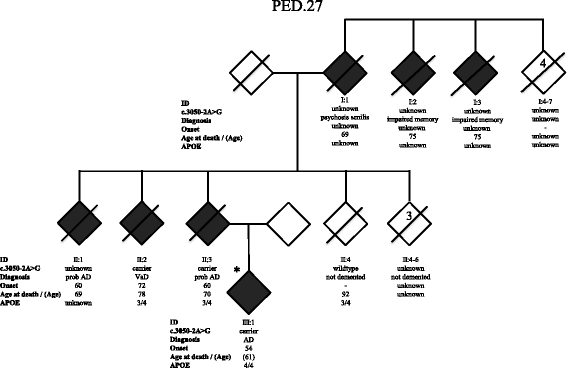
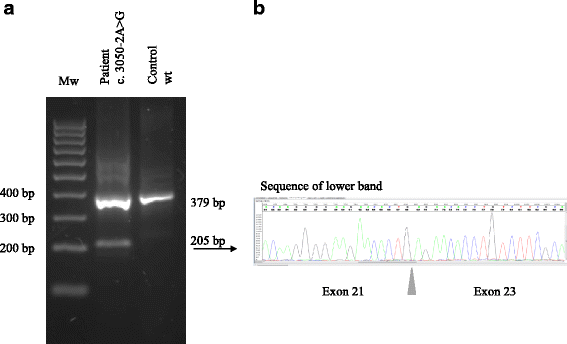
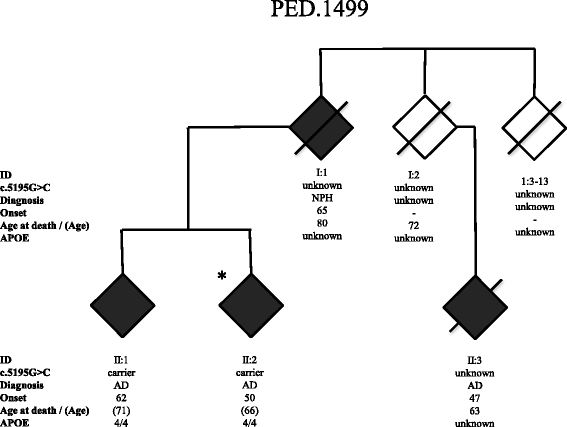

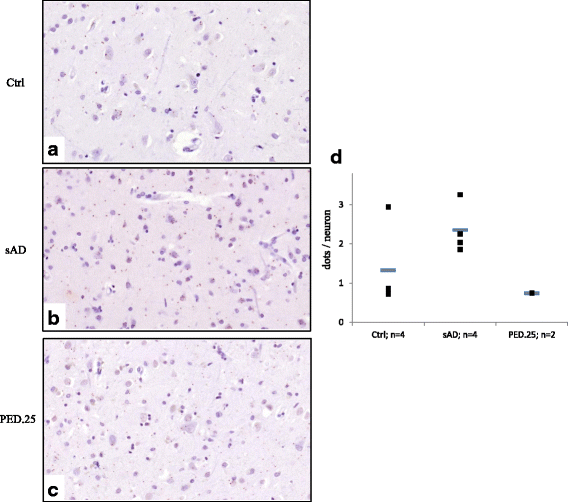
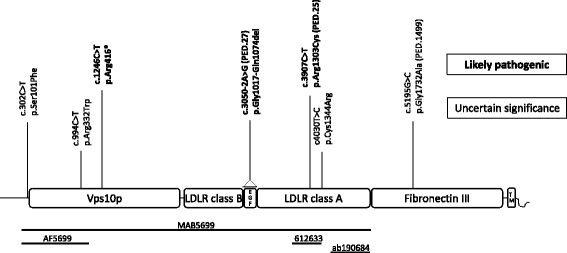
Similar articles
-
Novel Rare SORL1 Variants in Early-Onset Dementia.J Alzheimers Dis. 2021;82(2):761-770. doi: 10.3233/JAD-210207. J Alzheimers Dis. 2021. PMID: 34092641
-
A comprehensive study of the genetic impact of rare variants in SORL1 in European early-onset Alzheimer's disease.Acta Neuropathol. 2016 Aug;132(2):213-224. doi: 10.1007/s00401-016-1566-9. Epub 2016 Mar 30. Acta Neuropathol. 2016. PMID: 27026413 Free PMC article.
-
Molecular Genetics of Early- and Late-Onset Alzheimer's Disease.Curr Gene Ther. 2021;21(1):43-52. doi: 10.2174/1566523220666201123112822. Curr Gene Ther. 2021. PMID: 33231156 Review.
-
Early-Onset Alzheimer Disease and Candidate Risk Genes Involved in Endolysosomal Transport.JAMA Neurol. 2017 Sep 1;74(9):1113-1122. doi: 10.1001/jamaneurol.2017.1518. JAMA Neurol. 2017. PMID: 28738127 Free PMC article.
-
SORL1 genetic variants and Alzheimer disease risk: a literature review and meta-analysis of sequencing data.Acta Neuropathol. 2019 Aug;138(2):173-186. doi: 10.1007/s00401-019-01991-4. Epub 2019 Mar 25. Acta Neuropathol. 2019. PMID: 30911827 Review.
Cited by
-
A novel SORL1 mutation in a pedigree affected by early-onset Alzheimer's disease.J Alzheimers Dis Rep. 2025 Apr 2;9:25424823241296017. doi: 10.1177/25424823241296017. eCollection 2025 Jan-Dec. J Alzheimers Dis Rep. 2025. PMID: 40182695 Free PMC article.
-
A Super-Resolved View of the Alzheimer's Disease-Related Amyloidogenic Pathway in Hippocampal Neurons.J Alzheimers Dis. 2021;83(2):833-852. doi: 10.3233/JAD-215008. J Alzheimers Dis. 2021. PMID: 34366358 Free PMC article.
-
Is Alzheimer disease a disease?Nat Rev Neurol. 2024 Apr;20(4):245-251. doi: 10.1038/s41582-024-00940-4. Epub 2024 Feb 29. Nat Rev Neurol. 2024. PMID: 38424454 Free PMC article. Review.
-
The neuronal retromer can regulate both neuronal and microglial phenotypes of Alzheimer's disease.Cell Rep. 2022 Jan 18;38(3):110262. doi: 10.1016/j.celrep.2021.110262. Cell Rep. 2022. PMID: 35045281 Free PMC article.
-
Challenge accepted: uncovering the role of rare genetic variants in Alzheimer's disease.Mol Neurodegener. 2022 Jan 9;17(1):3. doi: 10.1186/s13024-021-00505-9. Mol Neurodegener. 2022. PMID: 35000612 Free PMC article. Review.
References
-
- Arango D, Cruts M, Torres O, Backhovens H, Serrano ML, Villareal E, Montanes P, Matallana D, Cano C, Van Broeckhoven C, et al. Systematic genetic study of Alzheimer disease in Latin America: mutation frequencies of the amyloid beta precursor protein and presenilin genes in Colombia. Am J Med Genet. 2001;103:138–143. doi: 10.1002/1096-8628(20011001)103:2<138::AID-AJMG1529>3.0.CO;2-8. - DOI - PubMed
Publication types
MeSH terms
Substances
LinkOut - more resources
Full Text Sources
Other Literature Sources
Medical

